METAIRIE, LOUISIANA
May 24, 2014
STRANGER: Mary Burns
LOCATION: Deanie’s Seafood, 1713 Lake Avenue, Metairie, Louisiana
THEME: An afternoon with a former teacher/zydeco dancer
Click here for part one of this interview
“I was suicidal,” said Mary Burns, shaking her head slowly.
She warned me that the story she was telling would be brutal. When my friend John and I had lunch with her at Deanie’s Seafood just outside of New Orleans, things started out upbeat. Mary, 68, spent the early part of the meal telling us all about her life as a teacher in a catholic school.
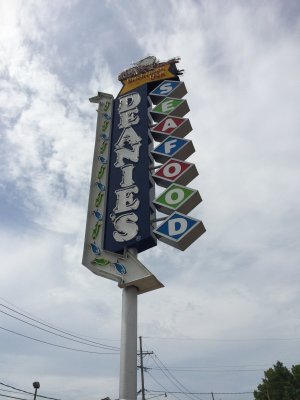
But she’s long since retired from teaching, and now spends her days dancing. Her favorite music is zydeco, a quick-paced, bouncy Cajun sound that lures her to the dance floor.
At the end of part one of my interview with Mary, she was about to explain how she first got into zydeco dancing. Her countenance changed as she took a deep breath. Normally she’s smiling, flashing pearly white teeth with a big grin, accented by her arched eyebrows that are tattooed on. Saves time on doing her makeup, she joked. But the smile was gone.
To prepare herself for telling the story of her entry into dancing, she leaned in close to the table. She spoke in a near-whisper. “It’s a brutal story,” she said. And then she began.
It all happened around the time of her divorce to her first husband. “I was suicidal,” Mary said, stony faced. “I decided I was going to end my life.”
Before she took her own life, she wanted to give some of her nicer belongings to a friend. Gathering them up, she called the friend, only to find out she was at Tipitina’s, a landmark live music venue in New Orleans. “My friend says come to Tip’s. All right. So I looked up the address, got the bag of stuff and went over. All I could think was that I wanted to get outta there, go home, and end my life.”
Then the music began. A zydeco band was playing. Mary was standing in a corner. She wanted the music to stop, hand her stuff to her friend, and leave. Permanently.
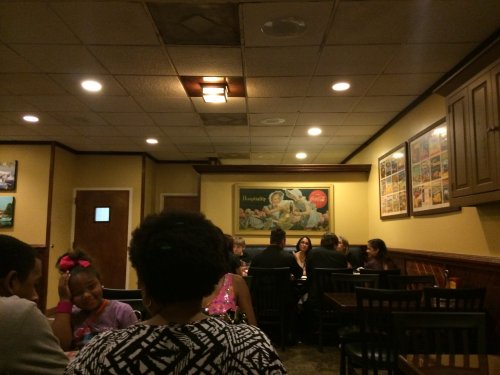
But fate or God or whatever intervened, as a man she didn’t know walked up to her and held out a hand, inviting her to dance. Nervous, Mary explained she’d never danced to zydeco before. The man insisted. “So I said, ‘All right, Lord, I’ll do this one last favor so I can get into heaven.’”
She took the man’s hand, and stepped onto the dance floor. It was awkward to start with. During her depression Mary said she had felt hunched over, a feeling of being encased in scales that were restricting her every move. Yet as the dancing continued and she picked up the pace to keep up with her partner, something changed. “I could feel the scales falling as I was dancing, I could sense that my joints were loosening up, my muscles were relaxing. Dancing freed me,” she said. “By the end of the night I was queen of the hop and never looked back.”
Her friend then asked her about the belongings that Mary was going to give her. Revitalized by the energy of zydeco dancing, Mary had found a reason to keep living. “I said, ‘To hell with that! Get your own shit!’”
She started dancing every week, developing what she called “a nice little group” of friends. And that’s how she met her second husband, a marriage she says was for love rather than her first marriage for what she called foolishness. She was with her second husband until his death a few years ago. “Our whole life revolved around dancing,” Mary said.
For her, life still centers on the dance floor. In addition to her weekly treks to live music venues such as Tipitina’s and Maison on Frenchmen Street, she also teaches zydeco dancing two nights a week. Zydeco is French Cajun music with a Creole bend, a funky, blues-influenced sound. The “true” style is sung in French, but Mary noted that younger bands sing in English.
As for the word zydeco itself, she said its origins are murky but it’s generally agreed it comes from the French word for snap beans which is pronounced “zy-dee-co,” and that the genre earned that name after a musician realized that when he kicked up the notch on Cajun music and played the zydeco style, people danced around with snappy movements.
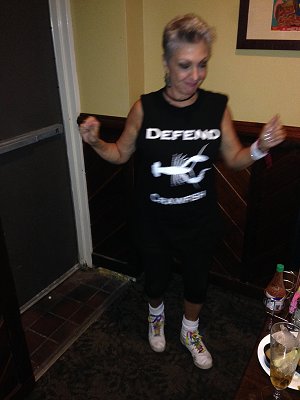
The fast pace is just one of the things Mary loves about dancing. “I have aches and pains. I hurt. Until the band starts. As soon as the band starts everything seems to hurt less.”
She sees dancing as one of the most primal forms of worship that uses the entire body. “When you’re dancing you’re using every muscle, it’s such a beautiful art form. I enjoy the physical, I enjoy the self-expression, I enjoy trying to pick it apart, I enjoy that aspect of it, finding the style, the little nuances of style in dancing,” she said.
That’s the approach she takes when he teaches zydeco dancing each week. “I tell my students not to focus on the basic steps. Focus on the style. Zydeco has a look,” Mary said.
What is that look?
“Well I’ll have to show it to ya!” Mary said with a smile, jumping out of her seat. The first trick is to get students to stop their initial instinct to throw their shoulders around while dancing. And then the body starts to sway slightly, picking up the tempo until it breaks into a energetic series of twists, twirls and fancy footwork that would make Fred Astaire envious.
Mary was a teacher at a catholic school for 30 years before she retired, but with the dancing class she gets a new generation of students with a different subject. Her message to zydeco pupils is simple. “They come in terrified and I tell them to break those walls down. They need to learn the freedom to step out from their walls. Just go out there and have a great time.”
The dance floor of Maison is where Mary and I first met in January, and I had a great time then. That’s what inspired me to get back in touch with her on a return to New Orleans.
She agreed to an interview, and that’s why we were spending part of the day at a table in the corner of Deanie’s Seafood. It’s an unassuming building, with little to distinguish it except the eccentrically painted large ceramic oyster shell at the entrance. But the food hit the spot.
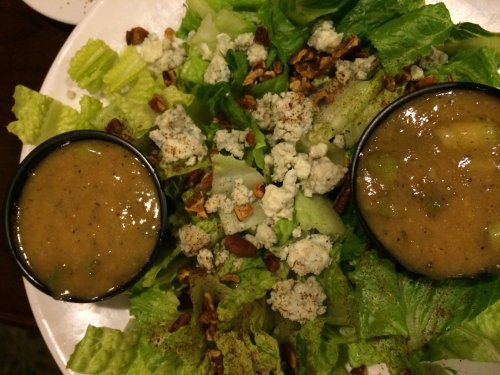
My vegetarian friend John had the artichoke hearts to start with, and for his main course moved on the Bucktown “blues” salad of romaine lettuce, with spiced pecans and crumbled Danish blue cheese, topped with a fig and balsamic vinaigrette. Looked tasty.
Due to overindulging in New Orleans’ culinary and beverage delights, my stomach wasn’t the happiest it’s ever been. So I played it safe with the catfish platter.
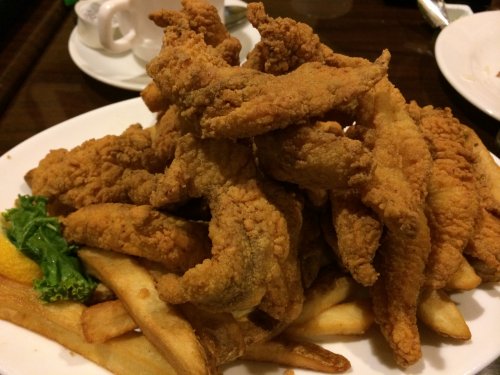
What a mound of food. Big chunks of deep-fried catfish sat atop a hefty bed of French fries. The batter on the fish was perfectly crisp, not too salty or greasy. And the flaky catfish had a great fresh taste, which is to be expected in a region obsessed with the best seafood. The crispy fries could have been a bit chunkier, but that’s a minor complaint for so much decent food.
Then things went a bit wrong.
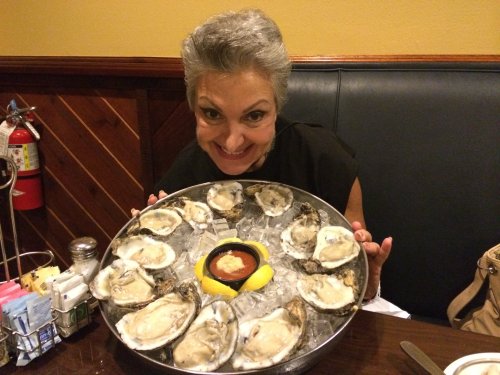
Mary ordered the dozen oysters on the half-shell. Which I’m sure is a great option if you love the little bivalves, but not the greatest sight if you’ve never tried one. And I hadn’t.
As soon as the huge plate of oysters — or “ersters” as Mary called them in her thick Louisianan accent — arrived, she dove in and downed a couple of them. “They’re perfect! This is Bucktown manna,” she said. Then she encouraged us to have a couple.
Gulp. I admitted I’d never had a raw oyster. I thought Mary’s eyes were going to pop out of her head in astonishment. So she jumped at the chance to teach me. With my friend John recording a video to mark the occasion, Mary sat by my side and walked me through losing my oyster virginity.
“Oh for God’s sake, you’re a wimp!” Mary laughed.
I happily deferred to her to eat the rest of the oysters. She was glad to polish them off, but joked, “Once I eat all these, nobody will wanna dance with me!”
Even solo, I’m sure she’d take to the dance floor and have a good time.
Much as dancing broke her out of suicidal thoughts, it remains a therapy for her today. It’s helped get her through devastating news, including her husband’s death and a rare liver cancer her daughter is battling with chemotherapy. “She’s 48, but she’s still my child. It’s such a helpless feeling, you want to do something,” Mary said, taking a brief pause.
“But when I’m dancing, it’s like nobody died, nobody’s in chemo,” she smiled.
Mary calls the small group of loyal friends who go dancing each week “The Wolfpack,” and the weekends of twirling on the dance floor give her something to look forward to. These are friends who’ve been through highs and lows together, including Hurricane Katrina.
That storm brought back Mary’s memories of Hurricane Betsy, which 40 years ago pounded the city. “My family’s house was wiped out for Betsy, and then 40 years later for Katrina. So when we have people in our house and they want a drink, we say to have the Betsy-Katrina double-punch. You drink it now and it wipes you out again in 40 years.”
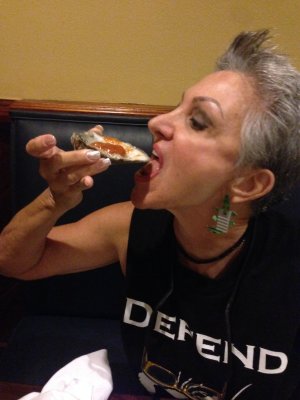
Mary chuckled, part of what appeared during the course of lunch as a natural instinct to laugh in the face of adversity and battle on through. Her mother and father lost their home during Katrina, and afterward Mary found herself tied up with endless phone calls and reams of red tape just trying to get them some assistance. Eventually she gave up, resigned to having to start anew. And at least Mary still had her own home, which survived because it’s located above the levee.
When Katrina was threatening landfall, she took refuge at a school 11 miles away — though her husband Jim stayed home. “He never left during a hurricane,” she said.
Mary packed a suitcase with two days worth of everything she’d need, and planned on being home shortly. But then the storm grew worse. As it hit, it blew the roof away from part of the school. “It was terrifying,” she said. “But you know what? I noticed how sharp my survival skills got.”
She teamed up with a small group of women to find an empty classroom, and they went about converting it into a more livable space during their temporary exile from their homes. By now about 24 to 48 hours had passed since she went to the school, and things were getting worse.
Looking out the window, she saw army trucks passing by. Not a promising sign. When she asked for information from one of the two policemen guarding the school, she was ordered back into the building. But it was becoming ominous inside. She remembers people slumped in wheelchairs on an upper floor, some possibly already dead — a grim image — and she refused to go upstairs again.

For many people that would have been the final straw. But for Mary, that came when the policemen guarding the school said everyone would be bussed out to Houston for safety.
Mary had to get out. She wanted to be back with her husband. She remembered that her father had once told her that if she were ever flooded out her home, she should follow the levees and they would take her anywhere. “And I realized I lived on the levee!” she said. With a butter knife in hand for protection, she resolved to walk the 11 miles of the levee back to her place.
She convinced one of the people staying at the school to divert the policemen’s attention and slipped out unnoticed. Then she waded through water and past destroyed houses on the lonely, wet walk home. When she walked through the front door of her largely unscathed house, her husband greeted her with surprise, asking what took her so long to get back. Mary laughed.
Katrina — which Mary calls “that bitch” — was nine years ago, but the memories are still vivid for her. She’s still angry at what she thinks was a deliberate move by the federal government to blow levees and flood poorer parts of New Orleans to save the historic French Quarter from devastation. And she’s disgusted with corruption she says occurred with recovery funds.
Those flashes of outrage however were brief, and most of the time during our lunch Mary kept a big smile on her face, with a contagious laugh. And she might get to express her feelings on Katrina through art, as a friend is writing a play about the 10th anniversary of the storm next year. He wants Mary, a budding amateur actress, to take on a role.
She’s open to the idea, as she’s done theatrical performances before. In addition to her zydeco dance classes, she also teaches drama to a group of senior citizens.
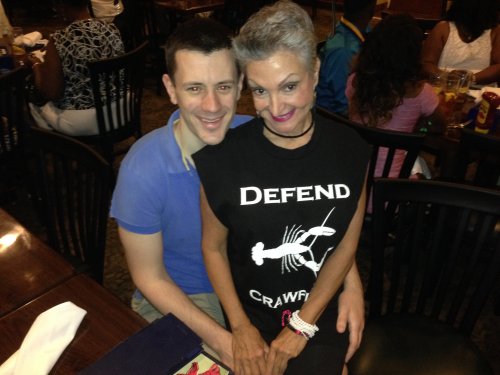
“They’re adorable, but they can’t remember their lines. So rule number one is that we don’t memorize anything. It’s all script-in-hand productions,” Mary said. Younger actors might chuckle if they see the older troupe having to perform with the script. “But when I see a young one laughing backstage, I know their little ass is going to be 68 one day.”
After lunch, Mary drove us around Bucktown and pointed out the insanely high levels of where the Katrina flooding once reached. She showed us houses that have, with the help of thousands of dollars of federal funding, been raised onto stilts to stand above future flood levels. And she stopped as we drove past the levee, lamenting the fact it’ll probably break again, with unknown consequences for the area.
But she wasn’t for making this a somber afternoon.
After a moment to reflect on what had happened during the storm and what might happen in the future, she smacked a button on her dashboard and the sound system sprang to life. There was the sound of an accordion — a hallmark of zydeco — and then Chubby Carrier started to sing his hit song “Zydeco People.”
The lyrics burst out of the speakers and filled the car:
We all come together
We sing real loud
In any kind of weather
‘Cause we’re Creole proud
Making good music
Is a whole lot of fun
Watching people dancing
And getting it done
Zydeco people
Is who we are
Zydeco people
We made it this far
“That’s my favorite song,” said Mary, singing along.
We made a quick pit-stop at her house so she could pick up her washboard and spoons (they’re rubbed up and down the board to make a distinctive raspy sound) and then it was time to head into New Orleans. She picked up a couple of members of the Wolfpack, and then after a short drive our group walked through the wide open doors of the venue Maison — a spacious and welcoming place.
Just like when I first saw Mary in January, I got to see her take to the dance floor and grab anyone who needed a dancing partner. This time I captured it on video, showing just how much fun Mary, bedecked in her “Defend Crawfish” shirt, has dancing around the place.
During one of Mary’s rare breaks from the dance floor, I managed to catch her and say my goodbye. Just as she’d hugged me tight when we first met at the restaurant, she clutched me close again and wished me all the best. And then the band started up again. The peppy Cajun rhythm filled the room. Mary started tapping her feet. Her smile grew broader. The band began to sing. She mouthed along with the words. And a few beats later, she was back on the dance floor.
o0dgsb
c05nxy